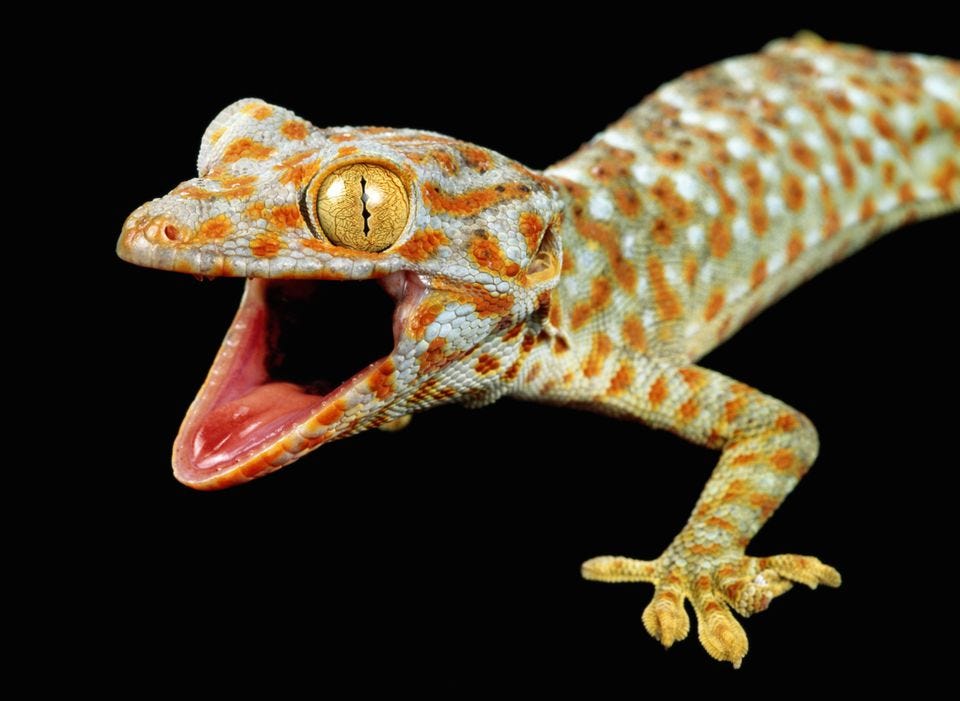
Geckos are another species of lizards from the family Gekkonidae. About 1000 species can be found all over the world, except on the Antarctica.
Geckos have developed different adaptations to survive in wide variety of ecosystems, such as: tropical rainforests, deserts, jungles, grasslands and mountains.
There are different beliefs and dispositions to wallgeckos, but then let’s explore their world and learn more about them, more so how to get rid of them because they can be nauseating around the house.
Check out these interesting facts about them…
· Geckos' amazing toes help them stick to any surface except Teflon.
· Besides well-developed night vision, geckos have excellent sense of hearing which help them detect and avoid predators on time.
· Geckos' eyes are 350 times more sensitive to light than human eyes.
· The name comes from the Indonesian Malay language – gekoq. Even in this language it is not a real word, but an imitation of the chirrups that the gecko makes when interacting with others of its species.
· Geckos are able to produce various sounds for communication, including barks, chirps and clicks.

· Some species of geckos have no legs and look more like snakes.
· Most geckos can detach their tails — and regrow them later if necessary.
· Geckos use their tails to store fat and nutrients for lean times.
· Geckos can live a long, long time.
· Most species of gecko don’t have eyelids, so they lick their eyes to clean them.
· Geckos are masters of color.
· The satanic leaf gecko perfectly mimics dead leaves.
· Unlike many species, the gecko thrives around humans. In warm regions of the world the arrival of gecko in to the home is greeted as a sign of good luck as they can help rid the house of unwelcome insects – they love a bit of mosquito for supper.

· Some gecko species can fly. Flying gecko is the only gecko species capable for flying (gliding through the air). It has webbed feet and tail, and wide flap of skin which act as a parachute while gecko jumps from one tree to another
· The smallest gecko species is less than 2 centimeters in length.
· Geckos come in a wide range of sizes. The smallest gecko (and the smallest lizard) is the tiny dwarf gecko. It grows to miniscule 0.6 inches (1.6 centimeters) long and weighs around .0042 ounces (120 milligrams).
· Geckos are found on every continent except Antarctica, and live in almost every habitat, including rain forests, deserts and mountains.
· The majority of geckos are nocturnal. This means they are awake at night and sleep during the day.
· Taking a bath is an interesting non-chore for geckos. Geckos have skin covered with hundreds of thousands of hair-like spines. These spines trap air and cause water to bounce off.

· Geckos give birth by laying eggs. The female can be pregnant with her eggs for years before she lays them. For example, the harlequin geckos' pregnancy lasts three to four years. When the eggs are ready, a gecko lays her eggs in leaves and bark.
· Geckos have score lines on their tails that allow them to snap off quickly if a predator grabs them. They then regenerate their tail.
· When a gecko falls, it twists its tail to a right angle to enable it to land on its feet. This stunt takes 100 milliseconds.
· Due to their small size, geckos are often preyed by snakes, birds, mammals and some large spider species.
· Female lays her eggs under the leaves and bark few weeks after mating. She does not take care of the eggs. Some eggs are soft, but their shell gradually hardens when exposed to air.

· Geckos have long lifespan. Leopard gecko can survive more than 20 years in captivity. Other species live between 8 and 10 years.
· Geckos can stick to walls and ceilings because of the attractive nature of intermolecular van der Waals forces. Van der Waals forces include attractions and repulsions between atoms, molecules, and surfaces, as well as other intermolecular forces.
· Geckos also secrete a liquid from a special gland. The gland enables them to excrete and absorb liquid according to the surface that they are on at any given time. In this way the liquid allows for maximum adherence to that surface.
· Geckos are parthenogenic. So, say for example, a female gecko washes up on a gecko-free island she can reproduce without mating with a male. However, when this happens these geckos will have a lack of genetic diversity which could mean shorter life spans and greater threat from diseases.

· Geckos like to shed their skins – a lot. Most species will do it at regular intervals, especially when they are around good water supplies. The leopard gecko will shed every two to four weeks. However, the gecko is a waste-not, want-not species and will eat the skin it sheds for the nutrients it contains.

If you however don’t want geckos in your home there are several things you can do. They are;
1. Keep Mothballs Around Your Home
2. Place Garlic Cloves
3. Pepper Spray the House
4. Have a Cat
5. Cut Few Onion Slices and Place Them Around the Home
6. Place Sticky Traps
7. Have Some Eggshells Around the House
8. Eliminate All Food Sources of Geckos



No comments:
Post a Comment